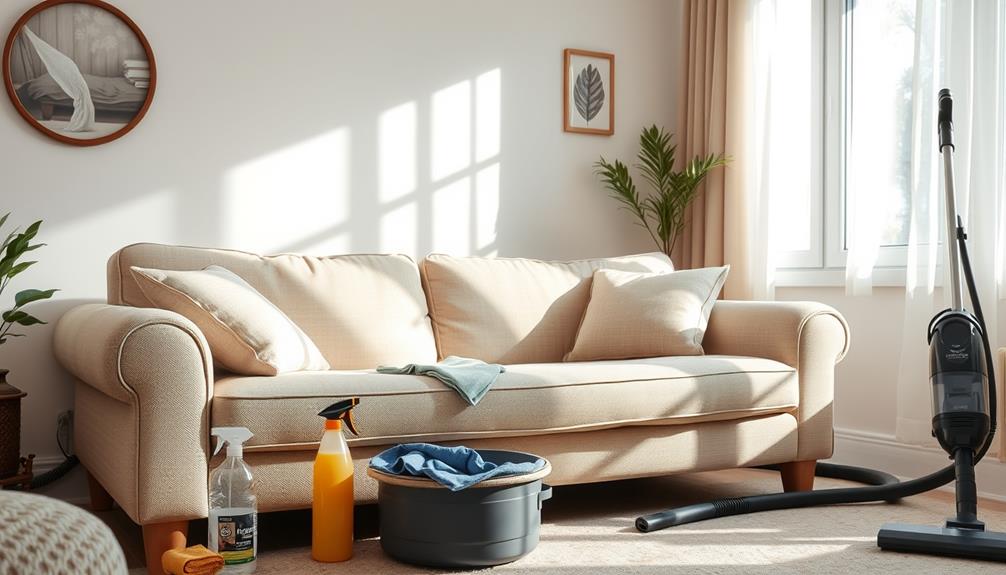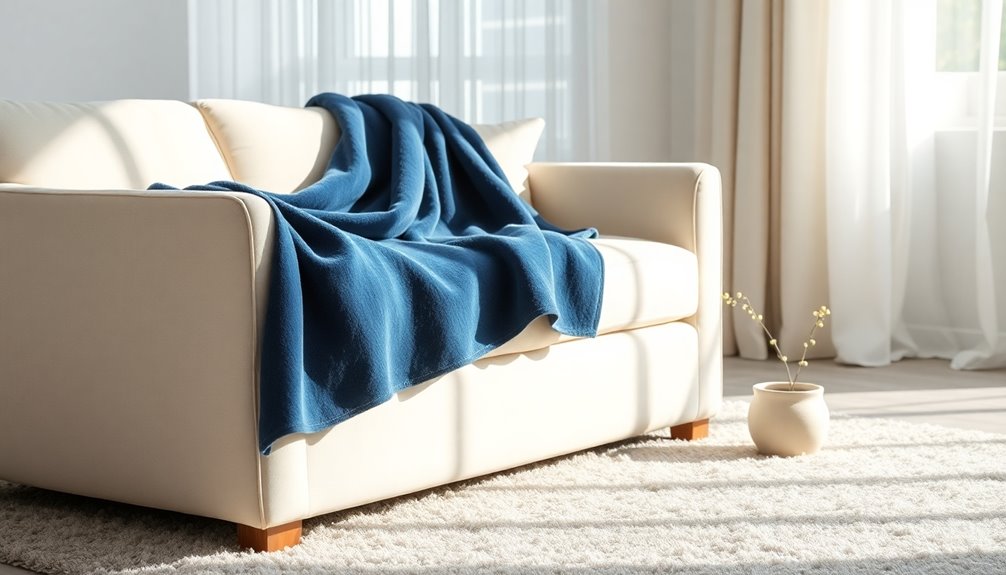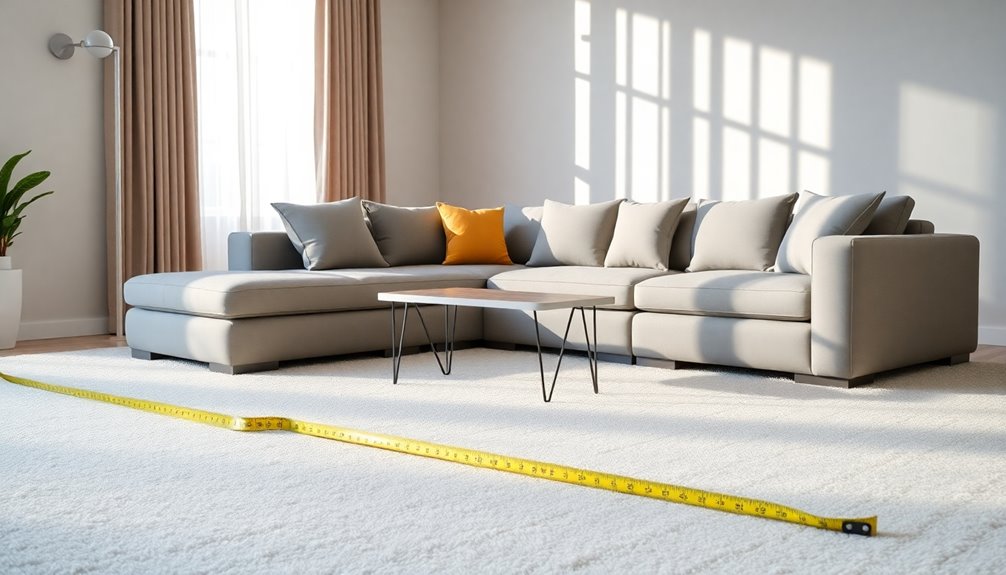To start cleaning your fabric sofa, first check the care tag for specific cleaning codes. Thoroughly vacuum to remove dirt and debris. For stains, combine distilled water, dish soap, and a splash of vinegar, then gently blot the stain with a microfiber cloth. Always test any cleaning solution on a hidden area first. If possible, consider steam cleaning for deep dirt extraction.
To eliminate odors, sprinkle baking soda on the fabric and vacuum it up after an hour. Regular maintenance involves weekly vacuuming and fluffing cushions. If you want to ensure your sofa looks great for years to come, there is more to explore!
Key Takeaways
- Read the manufacturer's care tag to determine the cleaning code and appropriate cleaning methods for your fabric sofa.
- Vacuum the sofa regularly to remove dirt and debris, ensuring the fabric stays clean and fresh.
- For stains, create a cleaning solution of distilled water, dish soap, and vinegar, and conduct a spot test first.
- Allow cleaned areas to air dry completely to prevent mildew and odors, using a fan for enhanced drying.
- Maintain your sofa by fluffing cushions, applying fabric protector, and promptly blotting spills to prevent stains.
Importance of Manufacturer's Instructions
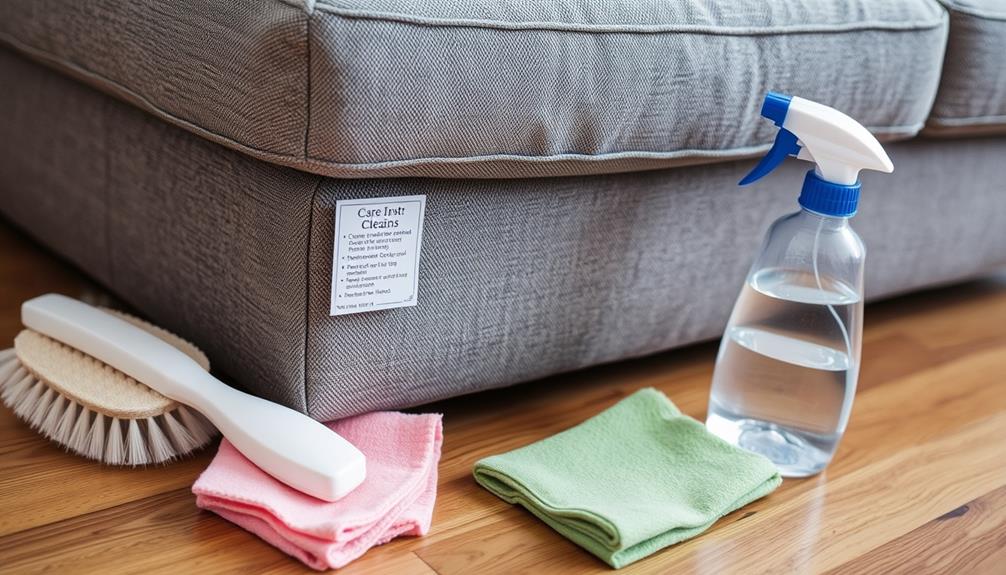
When it comes to cleaning your fabric sofa, understanding the importance of the manufacturer's instructions can't be overstated. These guidelines are essential for maintaining your upholstery integrity and ensuring the longevity of your investment.
Each sofa comes with care tags that detail specific cleaning methods tailored to your fabric type, similar to how mechanic shops for fuel injection cleaning emphasize the importance of following precise procedures for best results. Ignoring these instructions can lead to irreversible damage, potentially voiding any warranties.
By following the manufacturer's instructions, you can select the appropriate cleaning methods that not only clean your upholstered furniture effectively but also preserve its original appearance. This attention to detail prevents deterioration over time, keeping your sofa looking fresh and inviting.
Costly mistakes can easily arise from using the wrong products or techniques, which is why the manufacturer's recommendations are crucial. They provide you with the knowledge to care for your fabric sofa properly.
Understanding Cleaning Tags
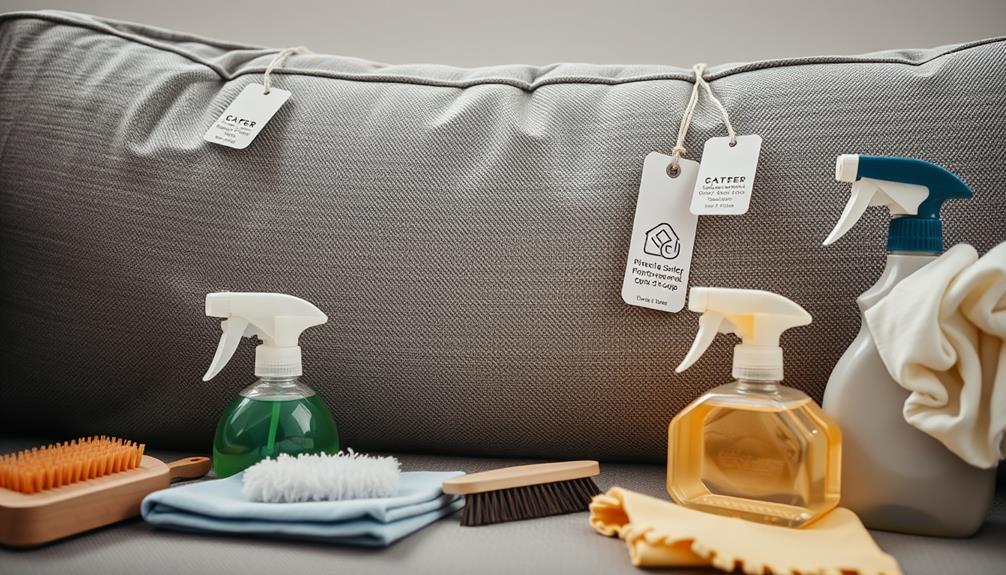
Before you start cleaning your fabric sofa, check the cleaning tag for important codes. These codes indicate what cleaning methods are safe to use, helping you avoid damage.
It's also useful to take into account how air quality can impact your upholstery, as air purifier maintenance dos and don'ts can influence the overall cleanliness of your home.
Knowing how to read these tags can save you from costly mistakes and guarantee your sofa stays in great shape.
Cleaning Code Definitions
Understanding cleaning tags is essential for maintaining your fabric sofa, as they frequently indicate the safest cleaning methods. Familiarizing yourself with the cleaning code definitions can help you choose the right approach without damaging your upholstery.
Here's a quick reference table for the common cleaning codes:
| Code | Cleaning Method | Description |
|---|---|---|
| W | Water-based cleaner | Safe for cleaning with water solutions. |
| S | Solvent-based cleaners | Only solvent-based products should be used. |
| WS | Water & solvent-based cleaners | Both cleaning methods are acceptable. |
| X | Vacuuming only | Only vacuuming is allowed; no liquids. |
Importance of Tag Reading
Reading the cleaning tag on your fabric sofa is essential for its upkeep. This small piece of fabric holds the key to understanding how to properly care for your upholstery. The cleaning instructions provided on the tag specify the appropriate methods for maintaining your sofa, ensuring you use either water-based cleaning or solvent-based cleaners as indicated by the codes.
For instance, using a vacuum designed for dust removal can be beneficial in maintaining your sofa's cleanliness and appearance, especially for those with allergies or pets Best Vacuums for Dust Removal in 2024.
You might find four common cleaning codes: "W" for water-based cleaning, "S" for solvent-based cleaners, "WS" for both options, and "X," which only allows vacuuming. Ignoring these cleaning instructions can lead to fabric damage, potentially voiding your warranty.
Additionally, the tag often reveals information about the fabric type, which is important for effective maintenance. By properly interpreting these cleaning codes, you can prevent damage and costly mistakes that may arise from using the wrong cleaning products.
Following the manufacturers' instructions not only extends the life of your fabric sofa but also keeps it looking its best. So, before you start any upholstery cleaning, take a moment to read that cleaning tag—your sofa will thank you for it!
Cleaning Stained Fabric Sofas
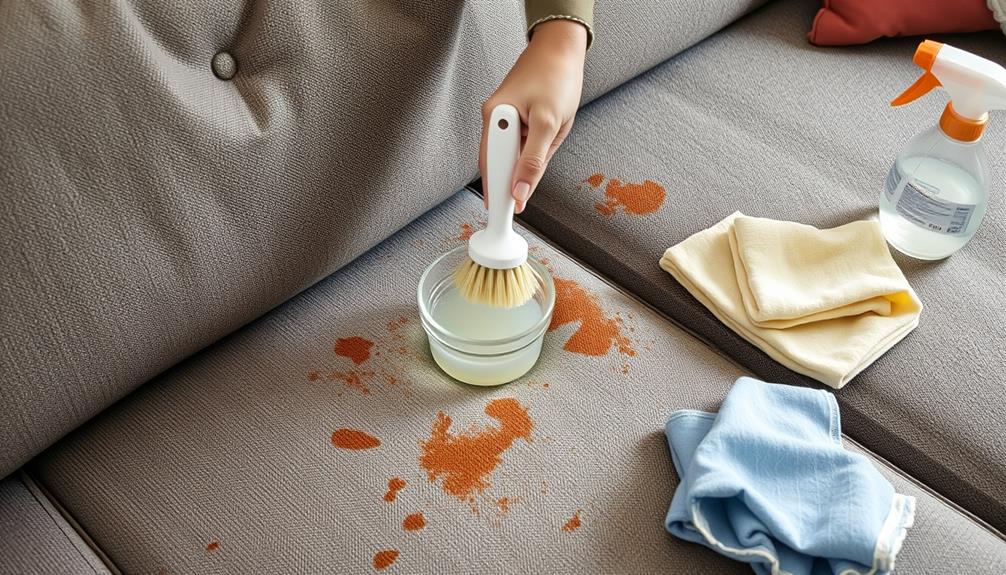
When tackling stains on your fabric sofa, it's essential to gather the right cleaning supplies first.
Using appropriate cleaning methods not only helps in stain removal but also protects the integrity of the fabric, similar to how selecting the right cold medications guarantees effective relief.
You'll want to use effective stain removal techniques that won't damage the fabric, and don't forget about proper drying and maintenance tips afterward.
Let's explore how to get your sofa looking fresh again!
Required Cleaning Supplies
Cleaning a stained fabric sofa requires the right supplies to tackle dirt and grime effectively. Start by gathering the essential items that will help you clean a fabric sofa efficiently. Here's a quick overview of what you need:
| Supplies | Purpose |
|---|---|
| Vacuum Cleaner | Removes dirt and debris from the sofa |
| Microfiber Cloth | Blots stains effectively without damage |
| Cleaning Solution | A mix of distilled water and dish soap |
| Care Tag | Provides specific cleaning instructions |
| Upholstery Cleaning Machine | For deep cleaning, if necessary |
To prepare your cleaning solution, mix distilled water and dish soap in a bucket. This combination is effective for tackling stains while being gentle on your fabric. Always check the care tag on your sofa for any specific cleaning codes or instructions to avoid damaging the material. After you've cleaned the stains, use a fan to dry the area thoroughly, preventing any mildew growth. With these supplies ready, you'll be well-equipped to tackle those pesky stains and restore your sofa's appearance.
Stain Removal Techniques
Stains on a fabric sofa can be a real eyesore, but with the right techniques, you can tackle them effectively. Start by vacuuming your sofa thoroughly to remove loose dirt and debris before addressing any stains.
For most fabric couches, you can create a simple cleaning solution using distilled water, dish soap, and vinegar. To guarantee your cleaning process is efficient, consider using a vacuum specifically designed for pet hair removal, which can help maintain your sofa's appearance if you have pets.
Dip a damp microfiber cloth into this solution and gently blot the stained area. Always perform a spot test on a hidden section of the fabric first to verify the cleaning solution won't cause discoloration.
If you're dealing with stubborn stains that won't budge, consider using a specialized upholstery cleaner. A portable machine like the Bissell Little Green Machine can also be a game changer for deep cleaning tough spots.
Once you've treated the stains, it's essential to allow the cleaned areas to air dry completely. If needed, use a fan to speed up the process and prevent mildew.
Drying and Maintenance Tips
To keep your fabric sofa in top shape after addressing stains, proper drying and maintenance are essential. After cleaning, verify the area dries completely to prevent mildew growth and odors. Use a fan for effective drying, and always check the manufacturer's care instructions to confirm the best method for your specific fabric—some may require air drying to maintain their shape.
Additionally, understanding the importance of maintaining a clean environment can greatly contribute to preventing moisture buildup.
While your sofa dries, avoid placing the cushions back on the cleaned area until the fabric is fully dry. This helps prevent trapping moisture, which can lead to mold or mildew. For quicker drying, open windows for ventilation during the cleaning process. Fresh air circulation will aid in the drying process and keep your sofa smelling fresh.
Additionally, regularly fluff and rotate your cushions as they dry. This simple maintenance tip helps restore their shape and prevents uneven wear.
Steam Cleaning Techniques
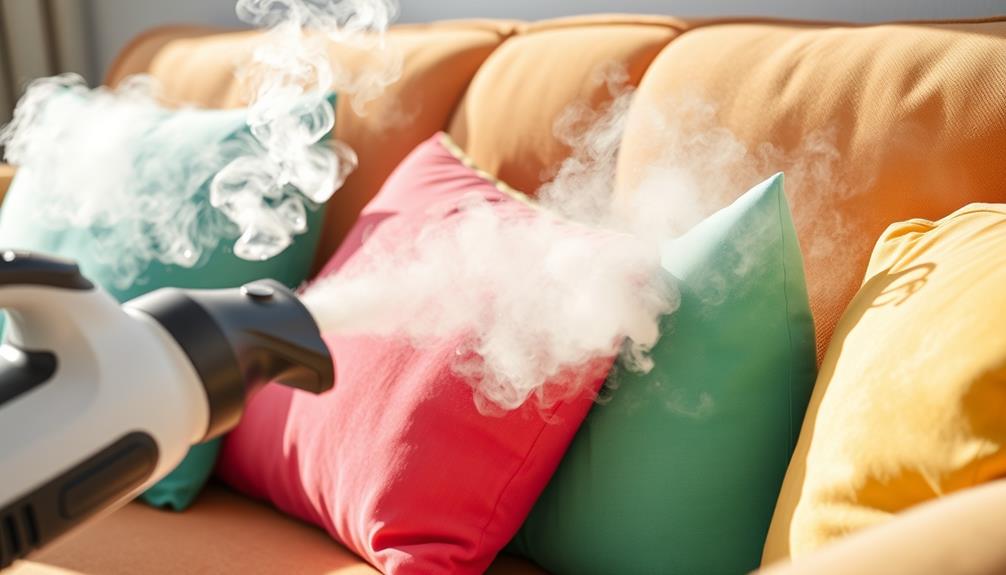
Often, steam cleaning can be an effective way to refresh your fabric sofa and remove embedded dirt. Before you start, check for "W" or "WS" codes on your care tag to verify your upholstery is compatible with water-based cleaning methods.
Always consult the manufacturer's cleaning instructions for specific settings to avoid damaging the fabric. Additionally, using energy-efficient appliances can contribute to a more sustainable cleaning routine while maintaining the longevity of your sofa.
Follow these essential steps for successful steam cleaning:
- Vacuum thoroughly: Remove loose dirt and debris to enhance the steam cleaning process.
- Verify proper ventilation: Open windows to help disperse moisture and improve air circulation while your sofa dries.
- Air dry completely: After steam cleaning, allow your upholstery to air dry fully. Consider using a fan to speed up the process and prevent mildew.
Odor Removal Strategies
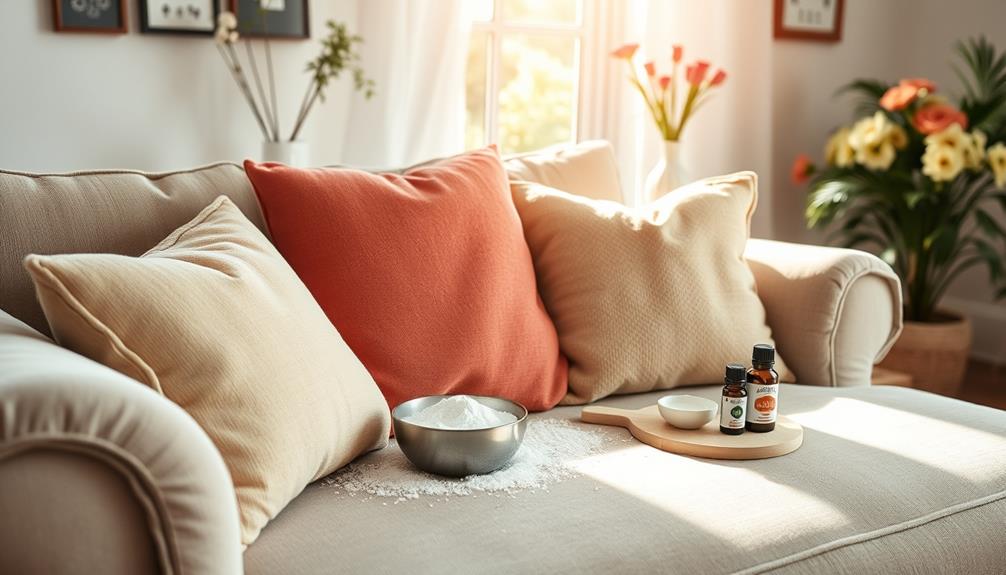
When it comes to maintaining a fresh-smelling fabric sofa, addressing odors promptly is essential. One of the simplest and most effective methods is using baking soda, a powerful odor absorber. Sprinkle it generously over your couch and let it sit for 20 minutes to an hour. This allows it to neutralize any unpleasant smells.
After the waiting period, vacuum thoroughly to remove the baking soda along with any loosened dirt or debris. Additionally, essential oils can be a great way to enhance your sofa's scent naturally; for instance, essential oils for respiratory health can provide a revitalizing aroma that elevates the overall atmosphere of your living space.
For more persistent odors, especially from pet odors, consider a homemade solution. Mix equal parts distilled white vinegar and water, then lightly spray the stained areas. Let it air dry, and you'll notice a significant reduction in odors.
If your sofa has removable covers, wash them according to the manufacturer's instructions to help eliminate smells trapped in the fabric.
Regularly cleaning your sofa and addressing spills immediately can also help prevent odor buildup over time. By incorporating these odor removal strategies, you'll keep your fabric sofa smelling fresh and inviting for years to come.
Regular Maintenance Tips
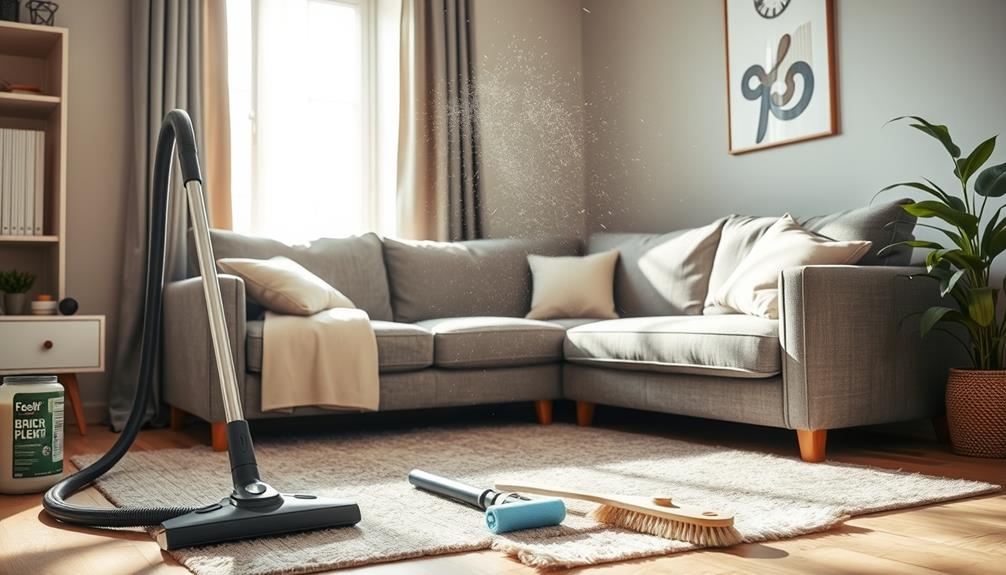
Keeping your fabric sofa in top condition requires consistent care and attention. By implementing a few regular maintenance tips, you can keep your living room looking fresh and inviting.
Incorporating natural materials and neutral color palettes in your decor can enhance the overall ambiance of your space, making it feel more cohesive and welcoming, especially when paired with a well-maintained sofa. For more inspiration on creating a harmonious living environment, check out modern farmhouse decor trends.
- Regular vacuuming: Aim to vacuum your sofa at least once a week. This helps remove dust, crumbs, and pet hair that can accumulate and dull your upholstery's appearance.
- Fluffing and rotating cushions: Every few months, fluff and rotate your cushions. This practice maintains their shape, prevents uneven wear, and enhances comfort.
- Use a lint brush: A lint brush is fantastic for quickly removing hair and dust between deeper cleanings, guaranteeing your sofa stays tidy.
Additionally, applying a fabric protector like Scotchgard can create a barrier against spills and stains. If an accident happens, promptly blot the area with a clean cloth to prevent permanent marks.
Deep Cleaning Techniques
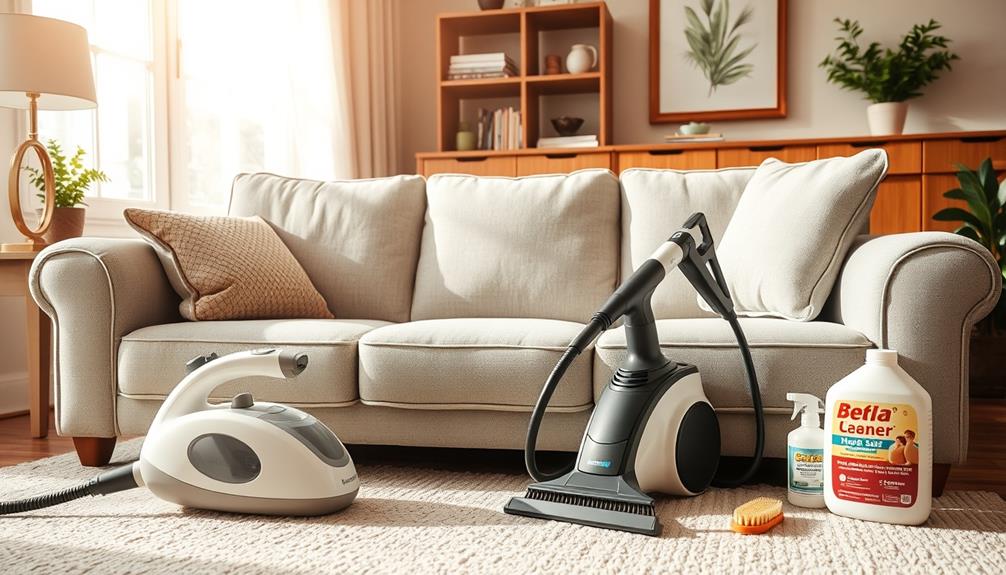
Deep cleaning your fabric sofa is vital for removing embedded dirt and stains that regular maintenance might miss. Start by using an upholstery steam cleaner, like the Bissell Little Green Machine, which effectively extracts dirt and stains from the fibers.
To truly honor the love and care that your sofa represents, consider incorporating wellness tips aimed at promoting a healthier lifestyle into your cleaning routine. Before applying any cleaning solution, always perform a spot test on a hidden area to verify colorfastness and prevent damage.
If your sofa has removable cushion covers, wash them in a cold/gentle cycle with a mixture of OxiClean and baking soda to maintain their appearance and hygiene. For high-use sofas or homes with pets, aim to deep clean every 12 to 18 months or more frequently as needed.
After using the steam cleaner, allow your upholstery to air dry completely. This step is essential to prevent mildew and guarantee the fabric retains its integrity.
Frequently Asked Questions
What Is the Best Way to Clean Sofa Fabric?
To clean sofa fabric effectively, start by checking the care tag. Vacuum regularly, use a gentle cleaning solution for stains, and apply baking soda for odors. Always act quickly on spills to maintain your sofa’s appearance. For additional sofa cleaning tips, consider using a handheld steam cleaner for deep cleaning or hiring a professional upholstery cleaner for tough stains. It’s also helpful to rotate and fluff your sofa cushions regularly to prevent uneven wear and tear. By following these sofa cleaning tips, you can keep your upholstery looking fresh and inviting for years to come. Additionally, to preserve the quality of your leather sofa, it’s important to understand how to maintain cream leather specifically. Regularly dust the surface with a soft, dry cloth, and use a leather conditioner every few months to keep the material supple and prevent cracking. When cleaning, avoid harsh chemicals and opt for products designed for leather care to ensure your sofa remains in pristine condition over time.
How Do You Clean a Fabric Couch Without a Machine?
Imagine a gentle breeze sweeping away dust; that's how you start. Vacuum thoroughly, check care tags, mix water, soap, and vinegar for spots, sprinkle baking soda for odors, then allow air to work its magic.
Can I Use Dawn Dish Soap to Clean My Fabric Couch?
Yes, you can use Dawn dish soap to clean your fabric couch. Just mix it with distilled water and vinegar, but make sure to spot test first to avoid any potential damage or discoloration.
What Is the Best Homemade Upholstery Cleaner?
"Where there's a will, there's a way." For the best homemade upholstery cleaner, mix equal parts distilled white vinegar and water with a few drops of clear dish soap. It's effective, eco-friendly, and cost-effective.
Conclusion
Now that you're armed with the know-how to clean your fabric sofa, you can keep it looking sharp—like it just rolled off the set of a 90s sitcom! Remember, following the manufacturer's instructions and tackling stains promptly are key. With regular maintenance and the right techniques, your sofa will stay fresh and inviting for movie marathons or cozy book nights. So go ahead, give your sofa the TLC it deserves, and enjoy your comfy space!
